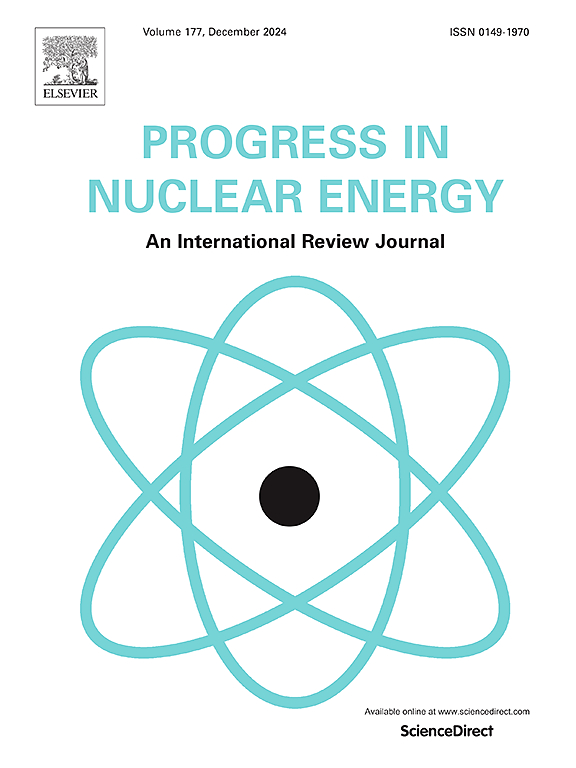自然循环核反应堆的三维效应研究:烟囱再循环
IF 3.3
3区 工程技术
Q1 NUCLEAR SCIENCE & TECHNOLOGY
引用次数: 0
摘要
本文探讨了采用自然循环(NC)的核反应堆运行动力学中三维效应的复杂相互作用。热-水力现象(THP)的回顾,与三维THP和NC的见解,以及他们在确定性安全评估中的作用进行了。此外,总结了与NC反应器相关的一些正在进行的研究方向,表明它们没有解决当前工作中强调的问题。在这项工作中,注意力集中在具有长烟囱的反应堆上,也称为提升管,热流体在其中向上运动,同时在周围的下降管中有温度较低的下降流。研究了烟囱内浮力驱动的再循环现象的潜在发生以及由此产生的冷流体进入核心区的风险。这种情况可能在不稳定性中沉淀,包括中子-热液压反馈。在本文中,我们考虑了包括过冷空洞在内的单相流动和两相流动,这两相流动分别是数控iPWRs和数控BWRs的典型特征。采用概念上简化的RELAP5-3D节点化,将烟囱区域划分为外围环形部分和中心圆柱形区域。烟囱内的再循环受到堆芯功率的影响,这也决定了容器内的NC流量。考虑到没有可用的实验数据,所进行的研究是初步的,并且使用系统代码RELAP5-3D代替更强大的CFD代码,可能更适合单相条件。本文章由计算机程序翻译,如有差异,请以英文原文为准。
Investigation of three-dimensional effects on natural circulation nuclear reactors: Chimney recirculation
This paper explores the intricate interplay of three-dimensional effects on the operational dynamics of nuclear reactors employing natural circulation (NC). A review of thermal-hydraulic phenomena (THP), with insights into three-dimensional THP and NC, as well as of their role in deterministic safety assessment has been performed. Moreover, some ongoing research directions relevant to NC reactors have been summarized, showing that they do not address the concerns highlighted in the present work. In this work, attention is directed towards reactors featuring a long chimney, also called riser, in which upward movement of hot fluid happens, together with a downflow with lower temperature in the surrounding downcomer. The study delves into the potential occurrence of buoyancy driven recirculation phenomena within the chimney and the consequential risk of cold fluid ingress into the core region. Such occurrences may precipitate in instabilities including the neutronic-thermal hydraulic feedback. In this work, we consider single phase flow including the presence of subcooled void and two-phase flow in the core region which are typical respectively of NC iPWRs and NC BWRs. Conceptually simplified RELAP5-3D nodalizations have been adopted, in which the chimney region has been divided into a peripheral annular part and a central cylindrical region. Recirculation in the chimney is affected by core power, which also determines NC flow inside the vessel. The performed study is preliminary considering that no experimental data is available, and the system code RELAP5-3D is used instead of a more powerful CFD code, perhaps more suited in case of single-phase conditions.
求助全文
通过发布文献求助,成功后即可免费获取论文全文。
去求助
来源期刊

Progress in Nuclear Energy
工程技术-核科学技术
CiteScore
5.30
自引率
14.80%
发文量
331
审稿时长
3.5 months
期刊介绍:
Progress in Nuclear Energy is an international review journal covering all aspects of nuclear science and engineering. In keeping with the maturity of nuclear power, articles on safety, siting and environmental problems are encouraged, as are those associated with economics and fuel management. However, basic physics and engineering will remain an important aspect of the editorial policy. Articles published are either of a review nature or present new material in more depth. They are aimed at researchers and technically-oriented managers working in the nuclear energy field.
Please note the following:
1) PNE seeks high quality research papers which are medium to long in length. Short research papers should be submitted to the journal Annals in Nuclear Energy.
2) PNE reserves the right to reject papers which are based solely on routine application of computer codes used to produce reactor designs or explain existing reactor phenomena. Such papers, although worthy, are best left as laboratory reports whereas Progress in Nuclear Energy seeks papers of originality, which are archival in nature, in the fields of mathematical and experimental nuclear technology, including fission, fusion (blanket physics, radiation damage), safety, materials aspects, economics, etc.
3) Review papers, which may occasionally be invited, are particularly sought by the journal in these fields.
 求助内容:
求助内容: 应助结果提醒方式:
应助结果提醒方式:


